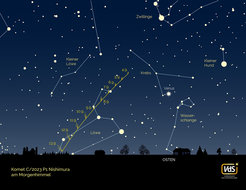C/2023 P1 (Nishimura): a comet for binoculars and photos
After C/2022 E3 (ZTF) at the beginning of the year, we get another short term visit from the depths of the solar system with C/2023 P1 (Nishimura). Like ZTF, Nishimura reaches a brightness that makes it an object for binocular, but due to its proximity to the Sun, observing it is challenging.
C/2023 P1 (Nishimura) was discovered discovered only a few weeks ago on 12 August by Japanese amateur astronomer Hideo Nishimura. With a brightness around 7 mag in in early September, it is now rapidly approaching the Sun and will be observable at up to 4 mag low over the morning northeastern sky. The astronomical magnitude scale, with the unit magnitudo (abbreviated mag), assigns smaller numerical values to greater magnitudes. Stars with a magnitude of 6 mag are barely visible as a dot with the naked eye under good conditions. The dwarf planet Pluto on the other hand does not get brighter than 14 mag and therefore you always need a telescope to see it.

Nishimura reaches its perihelion, the closest approach to the Sun, on 17 September, at a distance of 0.23 AU. One astronomical unit (abbreviated 1 AU) corresponds to the mean distance between the Earth and the Sun, which is about 150 million km. It is possible that Nishimura will disintegrate or break up as it approaches as it approaches the Sun.
Although Nishimura is nominally visible to the naked eye, observations are challenging. It rises just before sunrise along with the constellation of Leo. A clear view of the eastern horizon is therefore essential, and even with good viewing conditions without distracting light pollution, twilight interferes with its observation. To recognize it as a comet surrounded by a diffuse glow, the coma, binoculars are necessary.
Although it becomes a little brighter with each day, at the same time its angular distance to the Sun decreases, so that it is closing in on the horizon at dawn. From 13 September onwards, when the comet has an angular distance of only 13° to the Sun, it will probably no longer be visible in the brightened twilight sky.

Brighter comets often develop a distinctive curved dust tail whose particles reflect sunlight, giving a comet its typical appearance. For Nishimura, this is unfortunately not the case. It shows a straight, bluish ion tail, which is much fainter than a dust tail and only shows up well in longer exposed photographs. Therefore, it is worthwhile to take pictures of the comet with focal lengths higher than 200 mm. Fast optics keep the exposure times short to capture structures in the comet tail.
Since comets are always up to surprises, it is still worthwhile to look for Nishimura anyway. Maybe its brightness will increase more than expected.

